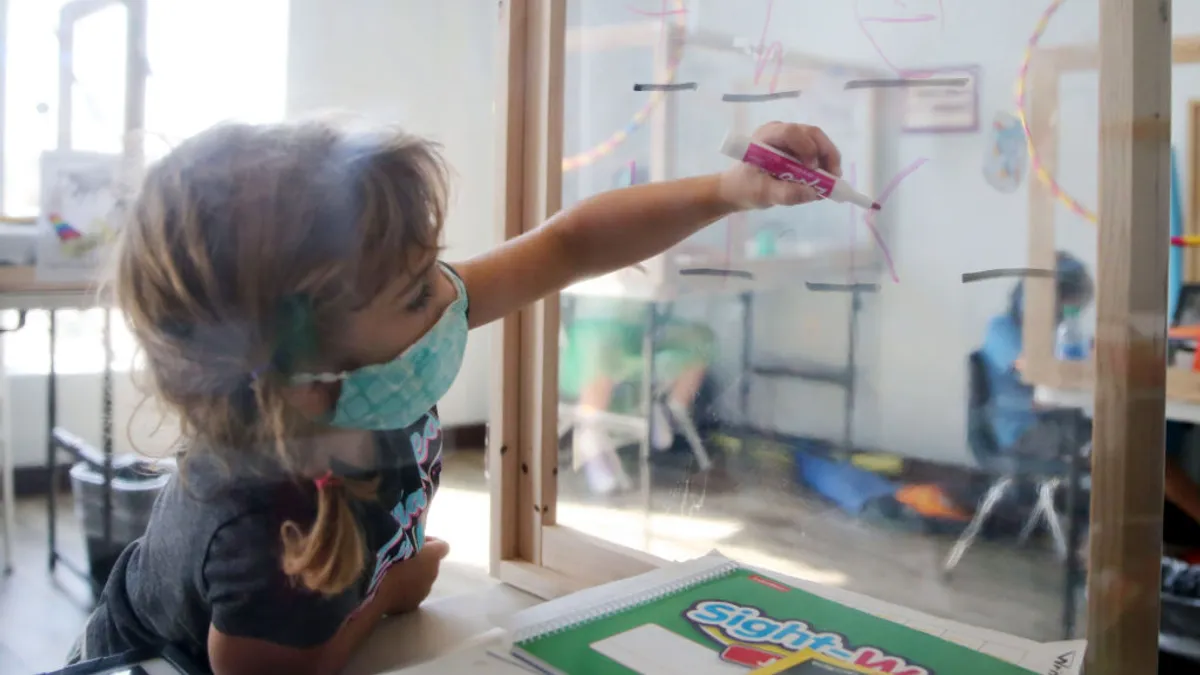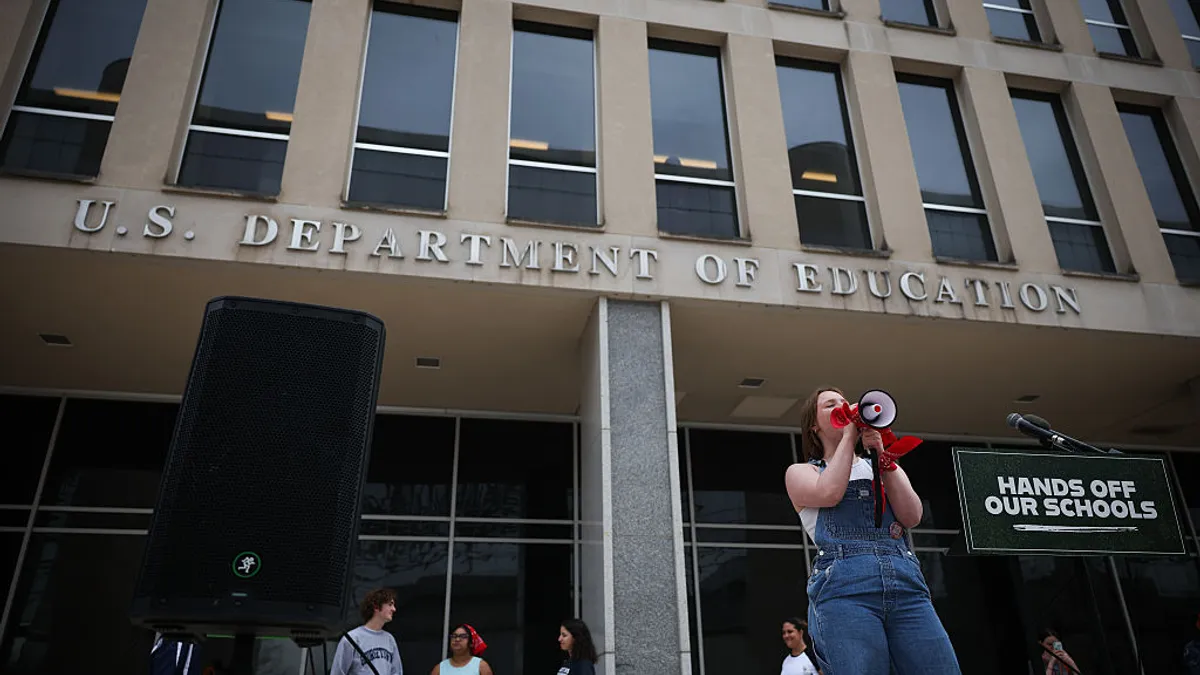School system leaders are cautiously optimistic that the 2021-22 school year will see more students learning in-person and that the school day will resemble pre-pandemic routines, but with safety protocols in place. Increased vaccine administration for adults and the hope of childhood vaccines this fall, winter or early in 2022 are helping drive this confidence.
Superintendents, however, say it’s difficult to predict the status of the pandemic five months from now. That uncertainty is pushing them to prepare for multiple scenarios as COVID-19 continues to be a major health crisis.
“So, big picture is flexibility and agility,” said Scott Muri, superintendent of the Ector County Independent School District in Odessa, Texas, which has 32,000 students. “Just like we did last year, we never know."
Muri added that while things are "trending in the right direction," some variables like virus variants could play a role in the next year. Flexibility and agility, in those cases, will continue to be important, he said.
With the end of the current school year fast approaching and planning for 2021-22 already underway, we asked Muri and four other superintendents across the country about their approaches in key areas.
Scheduling
Many school districts are planning to welcome all students in all grades to full-time in-person learning but keeping a virtual learning option for families not yet comfortable with sending their children to school campuses.
Nick Polyak, superintendent of Leyden High School District 212 in Franklin Park, Illinois, said his high school district with 3,500 students expects a majority of students will return to in-person learning next year, but does not know for certain yet the exact levels of participation. The first day of school for students is Aug. 12.
“It's challenging to know for sure because we cannot ask families to accurately predict their intentions so far in advance,” Polyak said in an email. “Because of that, we have plans in place for small amounts of requests and for larger amounts of requests so that we are able to pivot our efforts in the correct direction when we are able to gather more accurate information.”
Muri said currently about 70% of his district’s students are attending school in-person full-time, and he anticipates that number climbing to 90% next school year. In-person attendance has been greater at the elementary grades compared to the high school levels this year, he said.
A new discovery made during the pandemic for Ector ISD was the benefits of a staggered reopening for in-person learning. So next year, the first day of school will be Aug. 10 for Pre-K-6th grade and 9th grade. Aug. 12 will be the first day of school for grades 7-8 and 10-12. Allowing 6th- and 9th-graders to start school two days earlier will help those students settle into their new middle and high schools.
“They'll be the king of the hill for at least the first two days to get to know the campus, their teachers, the environment,” Muri said, adding that, if effective, it’s a policy that would continue into the future.
As district leaders make decisions about scheduling and logistics for next school year, they are relying heavily on guidance from their local health departments, plus state health and education experts. They’re also in dialogues with other school administrators in their regions, state or nationally. And they are reaching out to families to better understand their concerns and suggestions.
East Haven Public Schools in East Haven, Connecticut, is surveying parents and holding parent forums, said Superintendent Erica Forti. The district, which has nearly 3,000 students, has offered full-time in-person instruction all school year with the option of virtual instruction. About 70-75% of students are currently learning in-person, and it has not yet been determined whether the district will continue offering the virtual school option next school year, Forti said.
As the district continues to plan for next school year, it is also considering expanding the school day by 30 minutes at the elementary school level, which would be paid for with federal stimulus funding, Forti said.
“We're just really trying to be very, very diligent about responding to the data, responding to the feedback, and ensuring we do our part and our responsibility in directly tying those funds to the health, safety, well-being and academic achievement of our kids,” Forti said.
Staffing
Polyak said the Leyden School District is retaining teachers who instruct courses that saw decreased enrollment this school year because administrators anticipate course requests and staffing needs will trend back to normal next year.
“The curricular impacts of the pandemic have had strange effects on our course retakes and course requests for next year,” Polyak said.
Danny Merck, superintendent of the 16,400-student Pickens County School District in Easley, South Carolina, where the first day of school will be Aug. 3, wrote in an email that staffing for next year will resemble this year because the district will only have eight retirees out of the district’s 1,100 certified employees.
In the 28,000-student Richland School District Two in Columbia, South Carolina, staffing needs will be determined based on student enrollment, as well as forthcoming information from current teachers about their plans for next school year, said Superintendent Baron Davis. The district, which plans to offer in-person learning for all students as well as a virtual learning option, will be prepared to recruit more educators if needed, Davis said.
School systems are also considering strategic staffing models and increased professional development opportunities. Muri said Ector County ISD is looking at ways to expand student access to effective teachers. “A lot of attention is being paid to developing and cultivating great teachers and then to leverage the talent of great teachers more effectively than we've done in the past,” he said.
Learning
Richland School District Two is planning to offer four weeks of extended learning time this summer for students in elementary, middle and high school. The district is also considering extended school days next school year, said Davis.
“We're really trying to recoup all the lost instructional time so we're really going to dig deep and go into indicators of learning, standards, assessing students’ abilities, [and] trying to get them prepared, as prepared as we can, … to be successful in the next grade,” Davis said.
In the Ector County ISD this school year, some teachers are providing simultaneous instruction for in-person and virtual students. That model, which the district found was not effective for students, is being phased out. Next year, teachers will be dedicated to only in-person or virtual students, Muri said.
Several district leaders said they are using federal stimulus funds to add more time to the school day or school year. Ector County ISD plans to extend this school year and the next by 30 days for an optional learning program for elementary students, Muri said.
It’s not enough just to add instructional time, the superintendents agreed. The additional time has to be planned strategically so student learning is optimized. For example, Muri points to Opportunity Culture, an initiative by Public Impact that helps schools create multi-classroom leaders who mentor small teams of teachers through co-planning, coaching and modeling instruction.
In East Haven, Forti said although the district has not yet determined whether it will offer a virtual learning option next year, efforts are underway to look at improving both in-person and virtual learning programs.
“As educators, we are always striving to make things better and if the 2021-22 school year is going to require two different learning models, then what we did this year isn't going to be good enough,” Forti said. “We want to ramp that up. We want to make it better.”





















